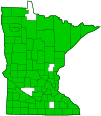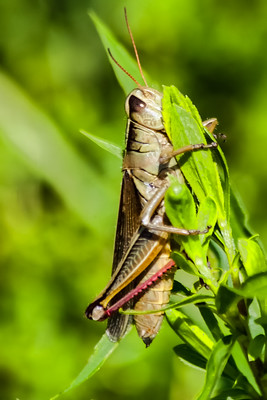two-striped grasshopper
(Melanoplus bivittatus)
Conservation • Description • Habitat • Ecology • Distribution • Taxonomy
|
|
||||||||||||||
Description |
Two-striped grasshopper is a large, very common and widespread, long-winged, spur-throated, short-horned grasshopper. It is highly variable in appearance but a few distinctive features, and its near ubiquity, make it relatively easy to identify. The overall coloration is usually yellowish-green to brown, rarely light green, with dark markings. The female is larger than the male. The face is vertical. The top of the head (vertex) is rounded in profile. The antennae are yellowish-brown to brown and are no more than ½ the length of the body. The plate covering the upper side of the thorax (pronotum) is flat above, not keeled, and broadly rounded at the end (posteriorly). It does not project over the abdomen. The upper side and upper lateral portions are blackish or brownish. A pair of yellow horizontal stripes extend from the above the compound eyes, over the head, and across the top of the lateral lobe of the pronotum, ending abruptly at the hindmost ridge (principle sulcus). There is a distinct, spiny bump (spur) at the base of the neck, between the base of the forelegs. There is a pair of flat, round, hearing organs (tympani) on the sides of the first abdominal segment. The lower end plate beneath the genitalia (the subgenital plate) is bulbous. On the male, the top edge of the subgenital plate abruptly curves upward. The sensory appendages at the end of the abdomen (cerci) are roughly boot shaped. On the female the ovipositor is short. The wings are long, brown or blackish, and well developed. They extend to the tip or almost to the tip of the abdomen when at rest. The forewings (tegmina) are dark and are not spotted. They have a pair of yellow, horizontal stripes that appear as a continuation of the stripes on the pronotum and head. The stripes converge at the end of the tegmina forming a triangle. The hindwings are clear, not banded or patterned, and are roughened on the upper surface. On the hind pair of legs, the outer face of the robust, third segment (femur) is dark on the upper half, dull yellow on the lower half. It is not banded. The dark and yellow regions are sharply demarcated. On all of the legs, the end section corresponding to the foot (tarsus) is divided into three segments and is arched in the middle. The hind tibia may be yellowish, greenish, or dark. They are never red. They have an outer row of 15 or more spines. The spines, at least at the tip, are black. The description above refers M. b. bivittatus, the interior west subspecies. On M. b. femoratus, the eastern and west coast subspecies, the overall coloration is often green. The hind femur is not sharply bicolored and may have a herringbone pattern. The hind tibia are always red. |
Size |
Male: 1⅛″ to 1 3 ⁄16″ Female: 1 7 ⁄16″ to 2 3 ⁄16″ |
Similar Species |
Habitat |
Upland fields, wood margins, marshes. |
Ecology |
Season |
Later June to early October |
Behavior |
They produce a low buzzing sound by rubbing the roughened hindwings against the hardened forewings. |
Life Cycle |
The female deposits a clutch of 50 to 108 eggs in the soil at the base of a plant. The eggs overwinter and hatch in the early spring. |
Nymph Food |
Shoots and other easily digested parts of the same plants that adults feed on. |
Adult Food |
A wide variety of mostly forbs but also grasses. |
Distribution |
||
|
Sources Haarstad, J. 1990. The Acrididae of Minnesota. Final report submitted to the Minnesota Department of Natural Resources. 28 pp. Cigliano, M.M., H. Braun, D.C. Eades & D. Otte. Melanoplus sanguinipes (Fabricius, 1798). Orthoptera Species File. Retrieved on 9/10/2024 at http://orthoptera.speciesfile.org/otus/816857/overview Hebard, Morgan. (1932). The Orthoptera of Minnesota. University of Minnesota. Minnesota Agricultural Experiment Station. Retrieved from the University of Minnesota Digital Conservancy, https://hdl.handle.net/11299/204015. |
|
| 9/10/2024 | ||
Melanoplus bivittatus femoratus, the eastern and west coast subspecies, and M. b. bivittatus, the interior west subspecies, both occur in the state. Where the subspecies come in contact they often intergrade but in most areas one subspecies displaces the other. |
||
Occurrence |
||
Very common and very widespread across North America. Common throughout Minnesota. |
||
Taxonomy |
|
Order |
Orthoptera (grasshoppers, crickets, and katydids) |
Suborder |
Caelifera (grasshoppers, locusts, and allies) |
Infraorder |
Acrididea (grasshoppers) |
Superfamily |
Acridoidea (short-horned grasshoppers and locusts) |
Family |
Acrididae (short-horned grasshoppers) |
Subfamily |
Melanoplinae (spur-throated grasshoppers) |
Tribe |
Melanoplini |
Genus |
|
Subordinate Taxa |
|
two-striped grasshopper (Melanoplus bivittatus bivittatus) two-striped grasshopper (Melanoplus bivittatus femoratus) |
|
Synonyms |
|
|
|
Common Names |
|
two-striped grasshopper yellow-striped grasshopper |
|
Glossary
Cercus
One of a pair of small sensory appendages at the end of the abdomen of many insects and other arthropods. In Odonata, one of the upper claspers. Plural: cerci.
Femur
On insects and arachnids, the third, largest, most robust segment of the leg, coming immediately before the tibia. On humans, the thigh bone.
Ovipositor
A tube-like organ near the end of the abdomen of many female insects, used to prepare a place for an egg and to place the egg.
Pronotum
The exoskeletal plate on the upper side of the first segment of the thorax of an insect.
Tarsus
On insects, the last two to five subdivisions of the leg, attached to the tibia; the foot. On spiders, the last segment of the leg. Plural: tarsi.
Tegmen
The modified, leathery front wing of some insects that protects the hindwing. It may also serve as a camouflage, a defensive display, or a sound board. Plural: tegmina.
Tibia
The fourth segment of an insect leg, after the femur and before the tarsus (foot). The fifth segment of a spider leg or palp. Plural: tibiae.
Tympanum
An external hearing structure. In reptiles and amphibians, the circular, disk-like membrane that covers the ear opening. In insects, the membrane covering the air sac and sensory neurons. Plural: tympani.
Visitor Photos |
||
Share your photo of this insect. |
||
This button not working for you? |
||
Nancy Falkum |
 |
Oronoco Prairie SNA Wild White Indigo ‘Baptisia lactea’ w/ Grasshopper |
Luciearl |
||
 |
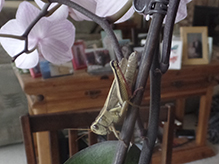 |
|
grasshopper on marigold |
||
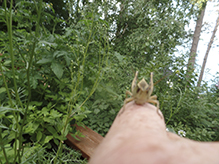 |
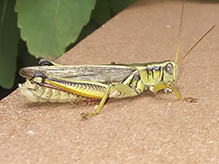 |
|
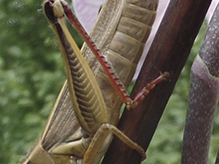 |
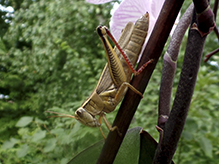 |
|
Alfredo Colon |
||
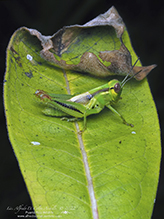 |
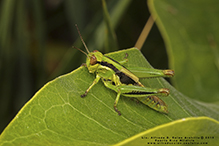 |
|
Scott Bemman |
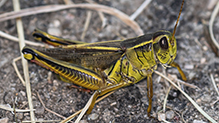 |
Bill Reynolds |
||
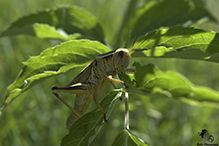 |
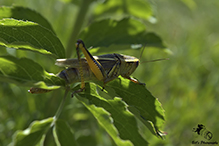 |
|
Female. She is chewing on Elderberry leaves. |
||
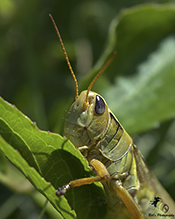 |
||
MinnesotaSeasons.com Photos |
||
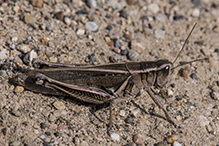 |
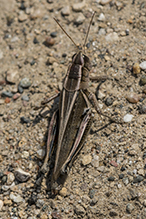 |

Visitor Videos |
||
Share your video of this insect. |
||
This button not working for you? |
||
|
Other Videos |
||
Two-striped Grasshopper |
About
Published on Jul 6, 2012 This video of a Two-striped Grasshopper (Melanoplus bivittatus) was filmed by one of our naturalists, Kent McFarland. Read his accompanying blog post "Jumping Gluttons" here: http://audubonguides.usmblogs.com/2012/07/06/jumping-gluttons/ |
Two-striped Grasshopper (Acrididae: Melanoplus bivittatus) Preparing to Oviposit |
About
Published on Sep 26, 2009 Photographed at Grand Forks, North Dakota (26 September 2009). |
Two-striped Grasshopper (Acrididae: Melanoplus bivittatus) Mating |
About
Published on Sep 7, 2009 Photographed at Grand Forks, North Dakota (06 September 2009). |
Two-striped Grasshopper (Acrididae: Melanoplus bivittatus) Female |
About
Published on Sep 2, 2010 Photographed near Fisher, Minnesota (25 August 2010). Thank you to David Ferguson (@Bugguide.net) for confirming the identity of this specimen! |

Visitor Sightings |
||
Report a sighting of this insect. |
||
This button not working for you? |
||
Luciearl |
Location: Fairview Twp. grasshopper on marigold |
 |
Nancy Falkum |
Location: Oronoco Prairie SNA Wild White Indigo ‘Baptisia lactea’ w/ Grasshopper |
 |
| Alfredo Colon 8/7/2022 |
Location: Albany, NY |
 |
| Luciearl 6/28/2022 |
Location: Lake Shore |
 |
| Scott Bemman Summer 2020 |
Location: Hayes Lake State Park |
 |
| Luciearl 7/26/2020 |
Location: Cass County |
 |
| Alfredo Colon 8/9/2019 |
Location: Woodbury, Minnesota |
 |
| Bill Reynolds 8/4/2017 |
Location: Pennington Co. Female. She is chewing on Elderberry leaves. |
 |
MinnesotaSeasons.com Sightings |
||

Created: 8/5/2017 Last Updated: © MinnesotaSeasons.com. All rights reserved. |
